Achieving carbon neutrality in the automotive industry
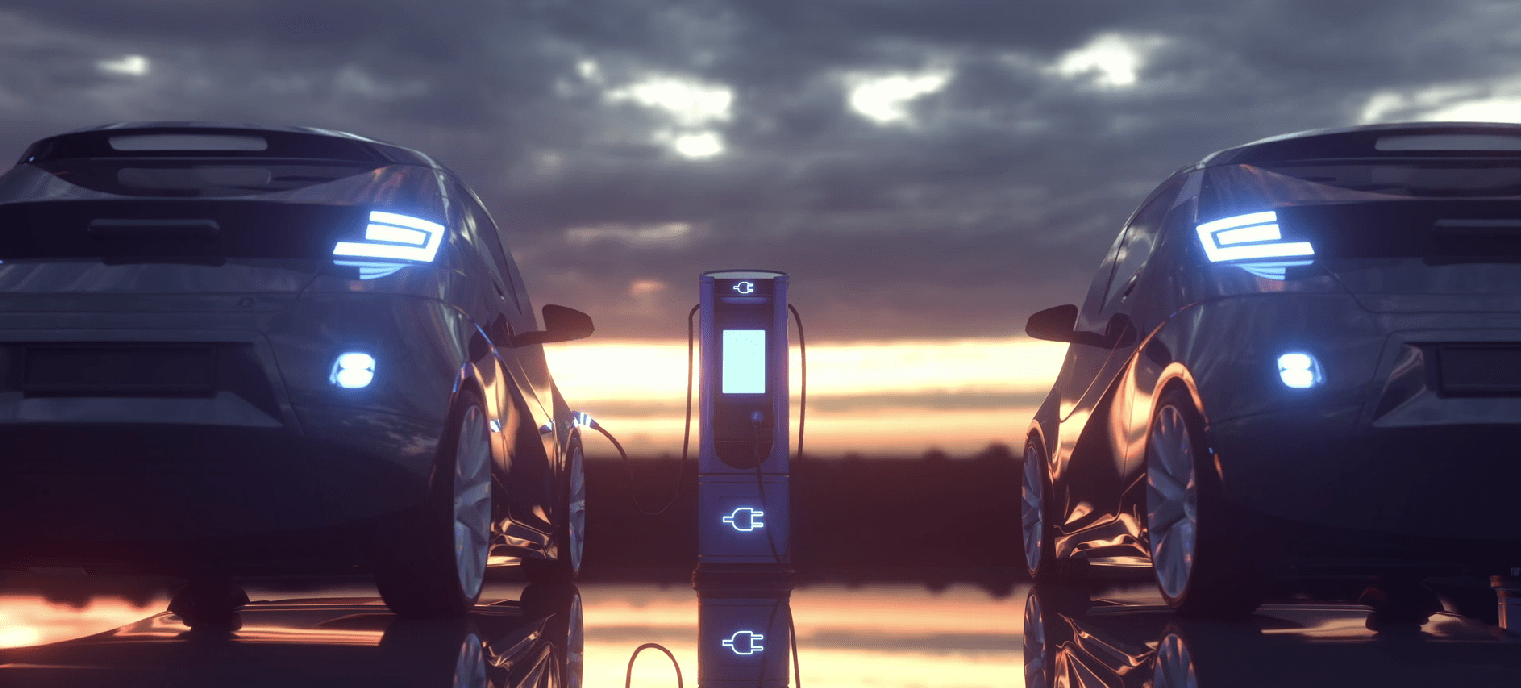
Valeo is at the forefront of the automotive industry’s shift towards sustainability, with a clear vision to reach net zero emissions by 2050. Its ambitious targets for 2030 include reducing its CO2 emissions from operating activities (Scopes 1 and 2 of the Greenhouse Gas Protocol) by 75% and upstream and downstream (Scope 3) emissions by 15%, in absolute terms, compared with its 2019 emissions, positioning Valeo as a forward-thinking carbon neutral company.
of sites certified to ISO 50001 (Energy Management) standard
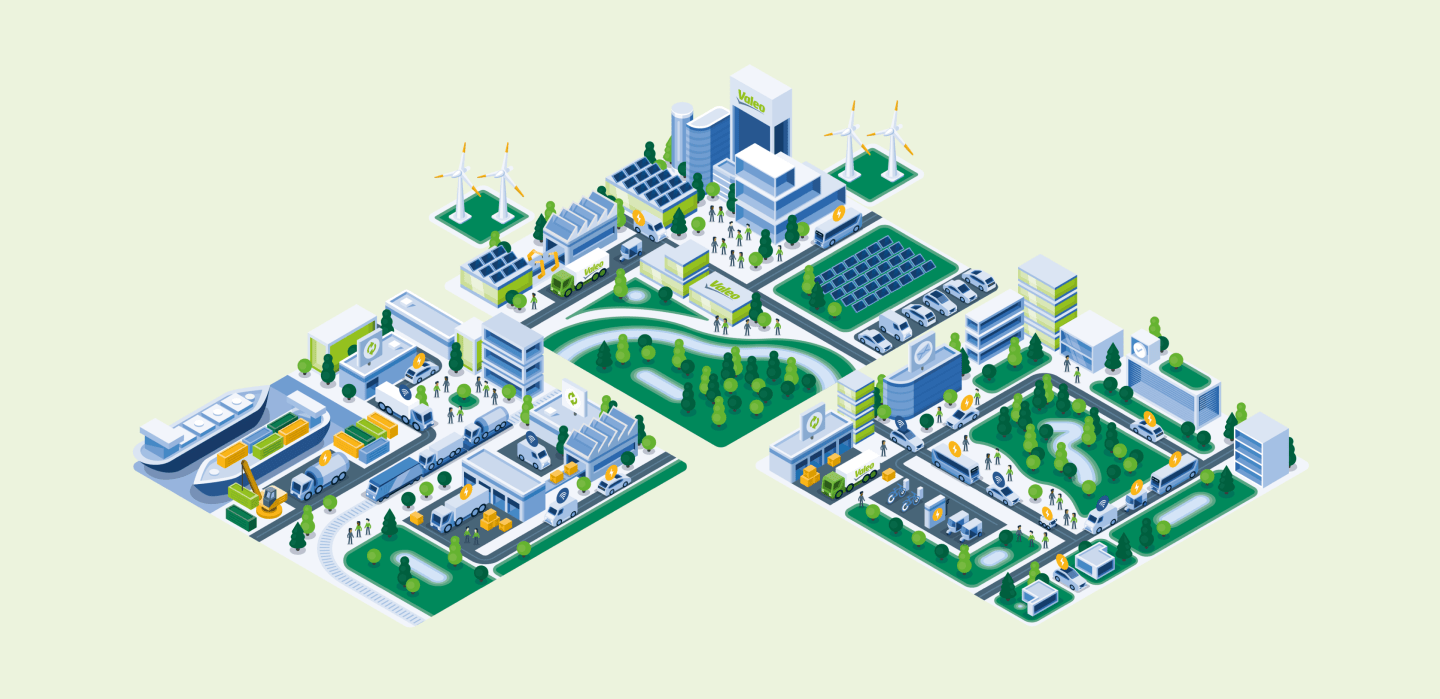
Embracing the future of sustainable manufacturing, Valeo’s CAP 50 plan has been defined in line with the CO2 emission reduction trajectories, defined in the Paris Agreements, to limit the rise in temperature to 1.5°C above pre-industrial levels.
The 2030 targets for GHG Protocol Scopes 1, 2 and 3 (upstream and downstream) are defined according to the Science-Based Targets initiative (SBTi) guidelines and have been validated by this initiative.
Due to the complexity of inter-sectoral harmonization, the methodology developed by the Science-Based Targets initiative (SBTi) does not currently allow for emissions avoided by the products sold by companies to be taken into account. However, this should not draw away from their positive contribution. Accordingly, the GHG emissions reduction commitment submitted by Valeo to the SBTi does not include the carbon benefits of the use of its technologies. The Group has pledged to ensure that its technologies enable third parties to directly avoid 13.6 MtCO2eq. of emissions (compared to 2019), equivalent to 27% of total 2019 emissions.
Emissions from Valeo operations (Scopes 1 and 2)
Scopes 1 and 2 correspond to direct and indirect greenhouse gas emissions linked to Valeo’s activities at its sites. The objective is to reduce these emissions by 75% by 2030 in absolute terms, compared to 2019. For a Group with more than 180 plants in almost 30 countries, this represents a major transformation, a testament to Valeo’s commitment to becoming a carbon neutral automotive leader.
Objective of reducing emissions by 2030
in investments between 2020 and 2030
To achieve this ambitious objective, Valeo will allocate more than 400 million euros in investments between now and 2030, focusing on the following levers:
- Improving energy efficiency at Valeo’s sites. Valeo is committed to ensuring its sites meet the highest standards in terms of energy performance. By 2022, 40% of sites were already ISO 50001 certified, the target initially set for 2025.
- Eliminating fossil fuels in operations. All Group sites are working to replace operations using gas and oil with alternatives, whether in industrial processes or logistics activities.
These comprehensive approaches underscore Valeo’s role in shaping a carbon neutral, sustainable future for the automotive industry.
Examples of carbon-neutral approach include:
Energy efficiency and eliminating gas
Nanjing – China
HTT RX Gas process elimination
377 tCO₂eq. per year
Nanjing – China
Energy efficient inverters
289 tCO₂eq. per year
Chatellerault – France
Calorie recovery compressor
38 tCO₂eq. per year
Seymour – USA
Installation of 6 Elspec units
1,750 tCO₂eq. per year
Daegu – South Korea
Compressed air/leakages fixed
371 tCO₂eq. per year
Chrzanow – Poland
Controlled air flow on injection machine
246 tCO₂eq. per year
Wenling- China
Inventory Air compressor installation
224 tCO₂eq. per year
Purchase of low-carbon energy. Reducing Scope 2 emissions involves sourcing energy with low CO2 emissions. This already accounts for 40% of the energy purchased in 2022, and the Group aims to reach 80% low-carbon energy by 2030.
On-site energy self-production. Valeo deploys low-carbon energy production facilities at suitable sites.
For example, sites in China and Malaysia use solar panels and Fischbach uses biomass.
Low-carbon energy self-production
Shenyang – China

Solar Panel
3,444 tCO₂eq. reduced per year
Wuhan – China

Solar Panel
1,492 tCO₂eq. reduced per year
Bad Rodach – Germany

Solar Panel
884 tCO₂eq. reduced per year
Penang – Malaysia

Solar Panel
2,920 tCO₂eq. reduced per year
Chonburi – Thailand

Panel THS
207 tCO₂eq. reduced per year
Sanand – India

Solar Panel
438 tCO₂eq. reduced per year
Low-carbon energy
Fujioka – Japan

16 heat pumps installed to cover 4 buildings
Savings 3,956 tCO₂eq. per year
Ciudad Juarez – Mexico

Paint process optimization
Savings 230 tCO₂eq. per year
San Luis Potosi – Mexico

Nitrogen Generator-Green Energy
Savings 176 tCO₂eq. per year
Fischbach – Germany

Replacing oil heating with biomass heating
Savings 364 tCO₂eq. per year and €128k yearly saving
By 2022, total Scope 1 and 2 CO2 emissions had already fallen by 39% compared with 2019 – a result already close to the 2025 reduction target of 41%.
Value chain emissions (upstream Scope 3)
Upstream Scope 3 covers greenhouse gas emissions generated before the production phase: extraction and processing of raw materials, production by suppliers, transportation to Valeo plants and logistics. By 2030, Valeo is committed to reducing its emissions by 15% on this scope in absolute terms, compared to 2019, aligning with its vision as a carbon neutral automotive leader.
Reduction of the upstream scope 3 emissions by 2030
In 2022, the Group had already exceeded the target set for 2025, reducing its upstream Scope 3 CO2 emissions by 7% compared to 2019.
Valeo is deploying a multi-pronged action plan to reduce its upstream Scope 3 emissions:
Value chain commitment: contributing to carbon neutrality is a priority that must be shared across the entire value chain. Valeo helps its suppliers move towards decarbonization through assessments, audits and targeted training. The Group requires its suppliers to make commitments that are aligned with its own GHG emissions reduction objectives.
Design for Environment: design teams take reducing CO2 emissions into account from the initial product design phases. This involves a number of levers:
- Making products lighter, to use fewer raw materials : contributing to the sustainable development of cars;
- Using recycled materials: emphasizing the renewable aspect of resources;
- Developing innovative, low-carbon footprint materials that meet the most demanding technical requirements, driving the automotive industry towards a carbon neutral future.
Innovative materials: a real success story in achieving carbon neutral goals
In order to offer its customers automotive products that are just as safe, but also more sustainable, Valeo has developed significant expertise in innovative materials, with teams dedicated to their development and to studying their various applications.
In particular, Valeo has chosen to work with organosheets, high-performance composites made from a fabric of long glass fibers embedded in a thermoplastic matrix. On average, Scope 1, 2 and upstream Scope 3 CO2eq emissions are reduced by 50% when using organosheets compared with aluminum, contributing the carbon neutrality of vehicles. Besides, organosheets offer superior flexibility and durability, while retaining the same shock-absorbing properties as metal, ensuring passenger safety and protecting electric vehicle batteries.
The properties of this sustainable material open up numerous opportunities for integrating technologies such as LiDAR or lighting supports, guaranteeing the stability of light panels and radars on the front end. Valeo already uses organosheets in a number of components, including:
- The organosheet crossmember, the world’s first structural part made from thermoplastic composite materials for mass production.
- The first organosheet housing for 48V batteries, in series production since 2020. This concept also applies to the front trunks.
- Front bumper beam under development with several customers.
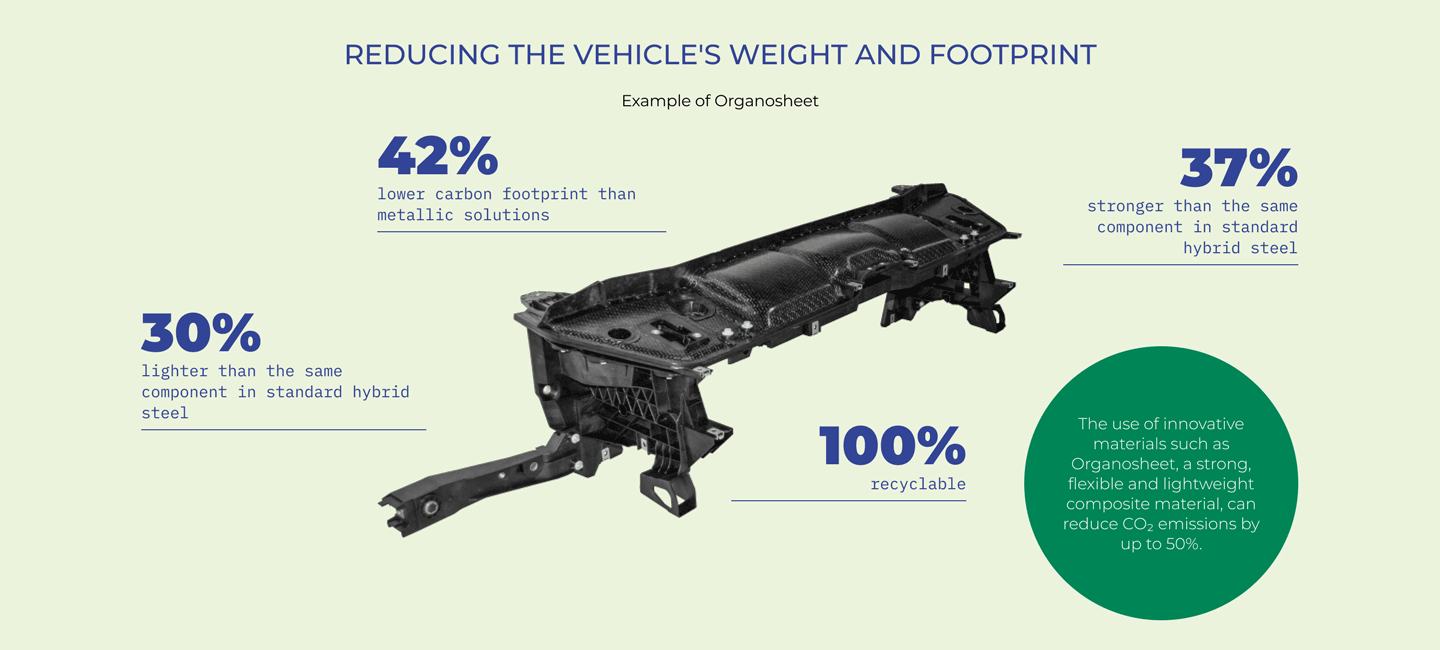
Recycled and bio-sourced materials inside vehicles
Another initiative to reduce carbon emissions from the production of materials in the automotive sector involves substituting plastics with bio-sourced alternatives, when this choice enables the technical properties of the final product to be maintained or improved. These technologies are rigorously tested to the highest standards by major automaker customers. These biomaterials are used, for example, in the manufacture of the following automotive components:
- Radiator housings: use of a plastic made from 50% castor oil.
- Headlamps: use of polycarbonate 70% bio-sourced from lignin, a component of wood.
- Ventilation systems, structural parts: use of recycled polypropylene filled with natural fibers (hemp, flax, miscanthus) instead of glass fibers or talc.
Bio-sourced plastics
Recycled aluminum alloys
Recycled Plastics
to come in 2025
In partnership with Renault, Valeo is co-developing an 800V rare earth-free electric motor with the highest level of performance. The carbon footprint of these motors will be reduced by 30%. Production is scheduled for 2027.
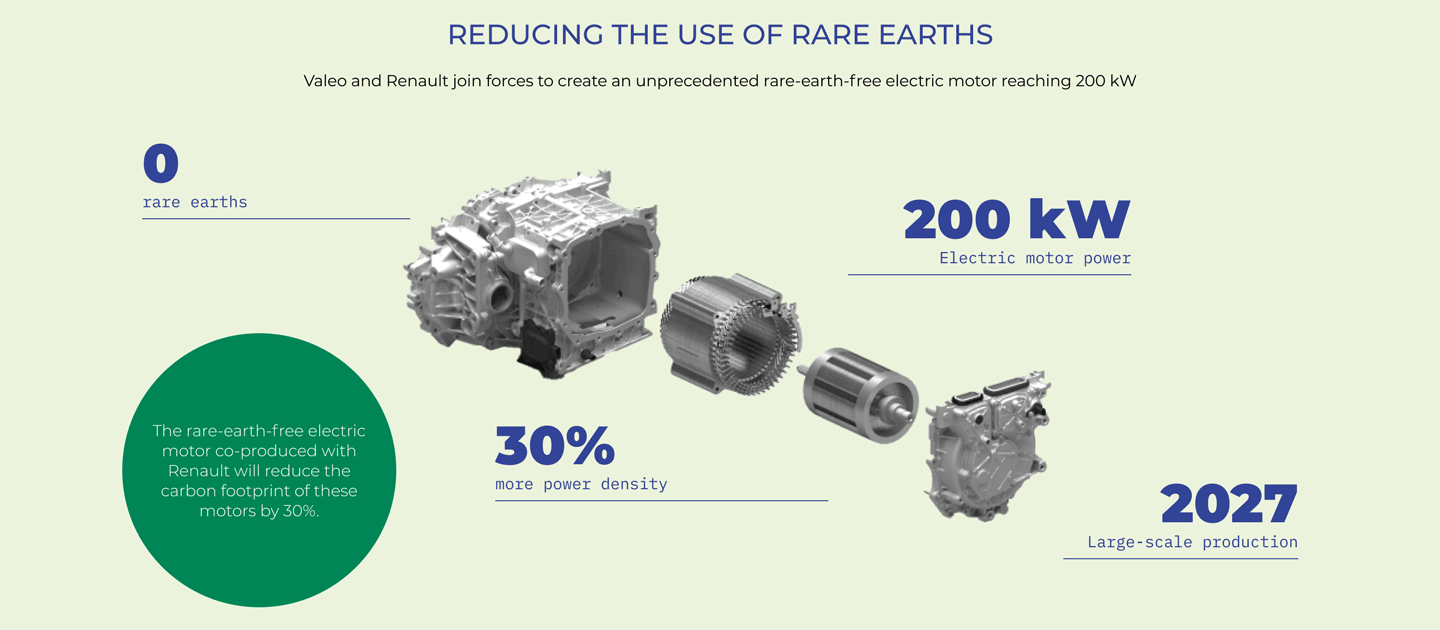
Carbon emissions from the use of Valeo products (downstream Scope 3)
Downstream Scope 3 includes greenhouse gas emissions linked to the use of Valeo products from when they are installed in vehicles to when they reach the end of their life.
Valeo is committed to reducing these emissions by 15% by 2030 in absolute value, compared to 2019. In 2022, the Group had already reached the 2025 objective by reducing our downstream Scope 3 emissions by 8% compared to 2019.
Reduction of the downstream scope 3 emissions by 2030
First lever: electrification
Downstream Scope 3 accounts for 80% of the GHG emissions of road mobility suppliers like Valeo.
Valeo technologies are key to electrifying road mobility. In 2024, one in three electric vehicles worldwide was equipped with Valeo technology.
Valeo electrification technologies: transition to carbon neutrality
- Optimization of combustion engines through innovative solutions such as the Stop-Start starter-alternator and the electric supercharger.
- Low- and medium-voltage electrification, with a 48V motor that can be used for light hybridization or to equip small vehicles.
- High-voltage electrification (voltages above 60V), with both the electric motor and the components needed to fully integrate the propulsion system: on-board battery charger, DC/DC converter, inverter.
- Thermal battery management. Valeo is a world leader in battery cooling systems, which are essential for longevity and performance.
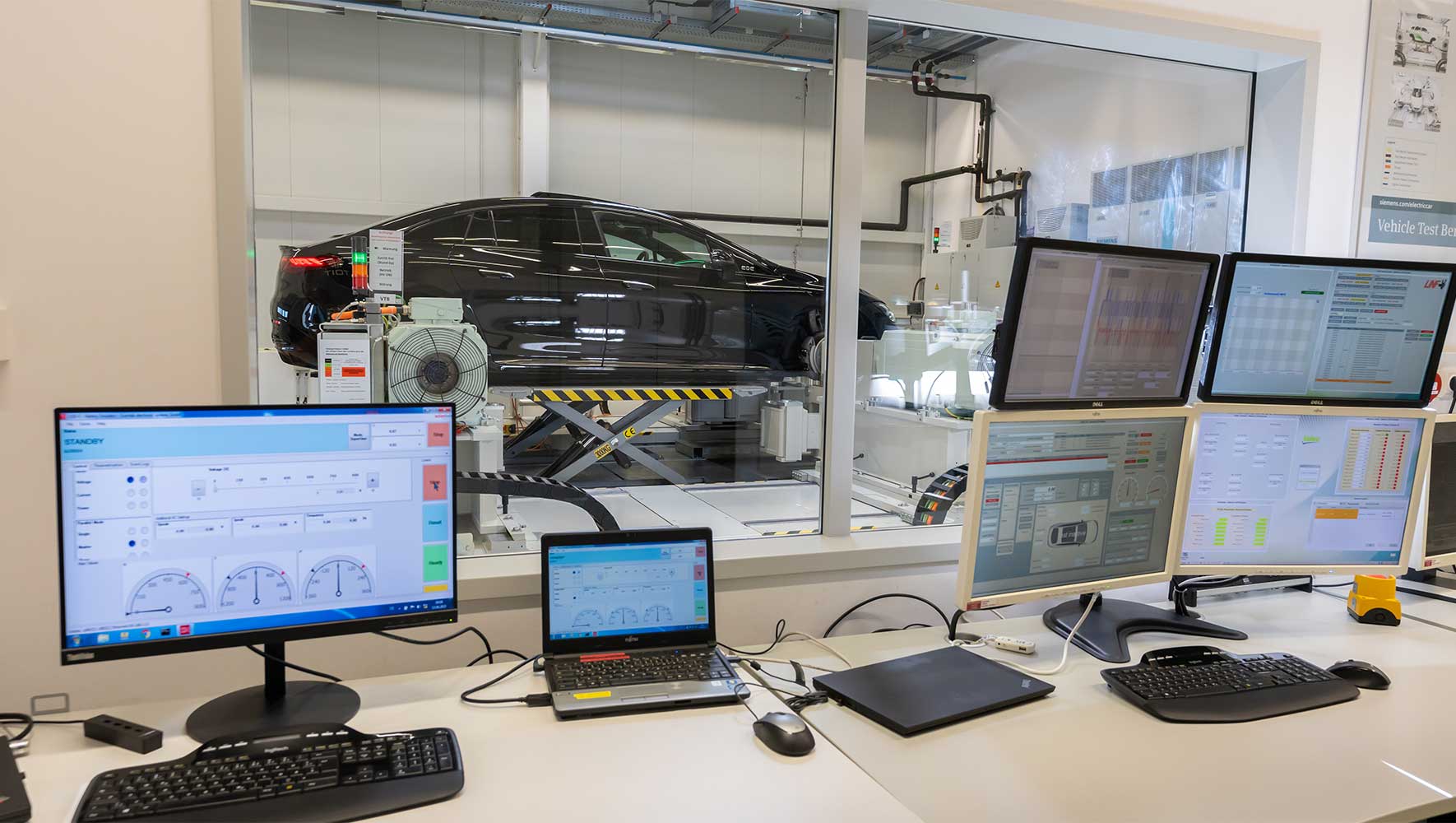
Valeo electrifies all forms of road mobility. The Group develops solutions for small, light, all-electric urban vehicles such as three-wheelers, scooters, bicycles and delivery droids. The technology meets the needs of urban mobility, i.e., easy, all-electric movement of goods and people with zero CO2 emissions and at an affordable price.
Switching from internal combustion engines to electric powertrains drastically reduces these emissions, as the electricity used to charge the vehicle is itself low-carbon.
That’s why Valeo’s 2050 commitments on this scope are on a regional scale. Reducing downstream Scope 3 emissions to zero is an objective that goes hand in hand with the electricity decarbonization trajectories to which the European Union has committed for 2050.
Energy efficiency and lighter materials for vehicles
Reducing vehicle weight and improving energy efficiency are two ways of reducing the energy required to run them, and therefore their downstream Scope 3 emissions.
With the Design for Environment eco-design approach, Valeo works on these two levers right from the early stages of projects:
For example, Valeo's organosheets parts are up to 30% lighter than their steel or aluminum equivalents.
Valeo uses LED technology in all its front lighting products, reducing CO2 emissions by 40% compared with technologies such as halogen.
Third-party carbon emissions avoided
Valeo technologies are key to electrifying mobility and enhance sustainable mobility solutions. Thanks to these innovations, it’s not just the Group’s emissions that are falling: electric motors and battery thermal management solutions are needed to decarbonize road mobility as a whole.
What are “avoided emissions”?
Avoided emissions correspond to the difference between GHG emissions in a baseline scenario and those in a scenario in which a decarbonization solution is used. This means looking at the impact of technologies at the level of the entire vehicle, not just the component.
Currently, Valeo’s commitments relate exclusively to emissions avoided in the use phase, thanks to its electrification technologies. Nevertheless, emissions in both scenarios are calculated over the entire life cycle (cradle-to-grave).
Reducing carbon footprint through automotive electrification
Automotive electrification is the most striking example of carbon-neutral challenge in Valeo’s technology portfolio. Equipping a car with an electric powertrain avoids emissions from the internal combustion engine which would have powered it otherwise.
However, Valeo’s sustainable objectives do not stop there. Some technological innovations lower the vehicle’s carbon footprint even though, at product level, they lead to an increase in the company’s SBTi carbon footprint. At present, Valeo’s objectives in terms of avoided emissions for third parties relate solely to electrification technologies.
Valeo currently uses attributional methods to assess a product’s contribution to the reduction in a vehicle’s carbon footprint.
Avoided emissions from Valeo’s eligible portfolio are aggregated based on the number of products sold.
Until the ICE ban comes into force in 2035, Valeo considers that each Valeo electric powertrain product sold enables the electrification of a vehicle in place of an internal combustion engine. Avoided emissions are therefore assessed compared to a baseline of a medium-sized car with an internal combustion engine, over the use phase only for the time being.
The 2019 avoided emissions baseline is subtracted to reflect improvement since then.
All avoided emissions assessments are verified by a third party.


